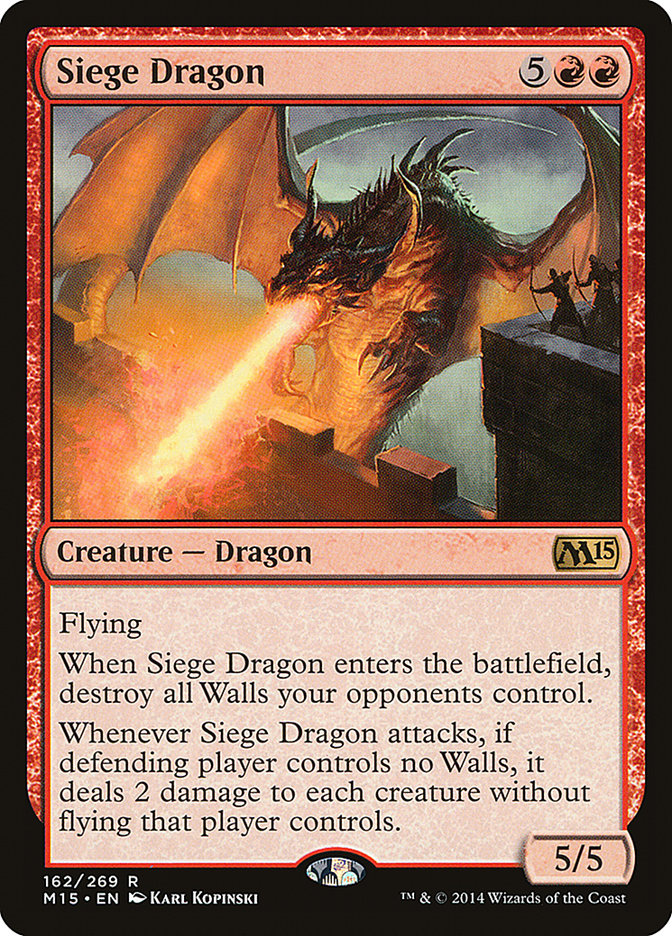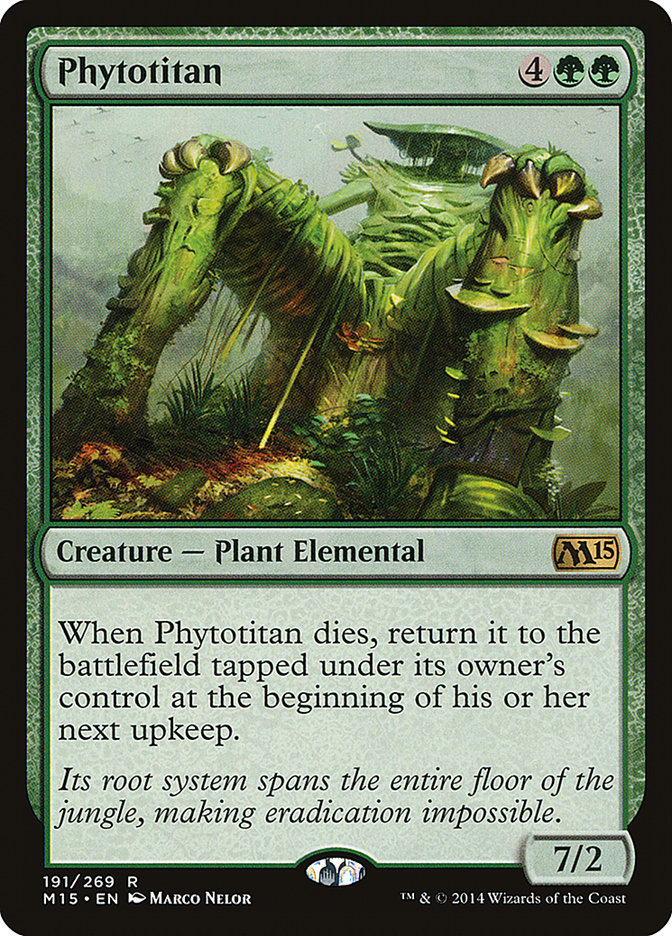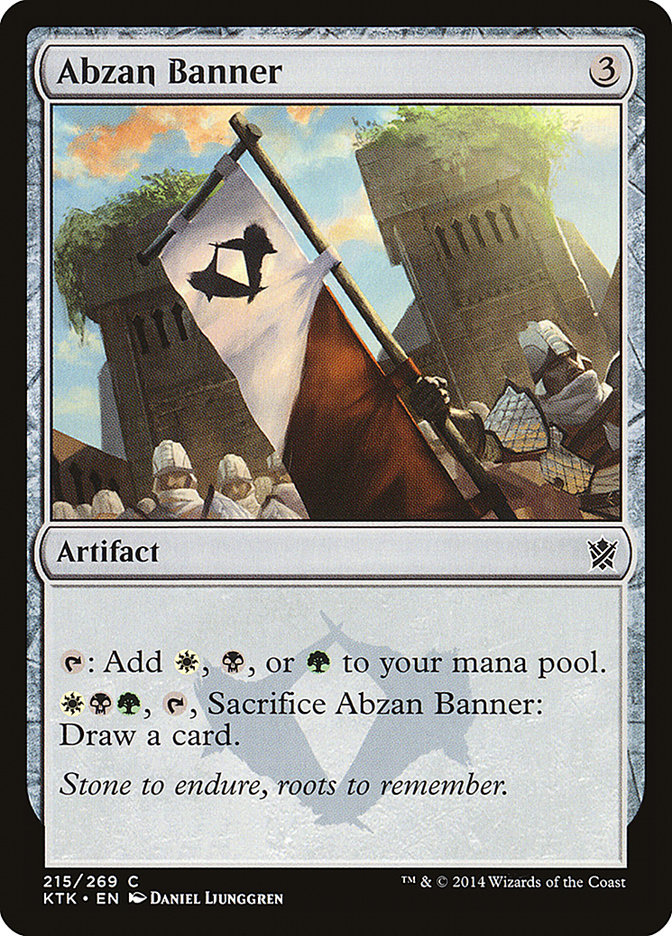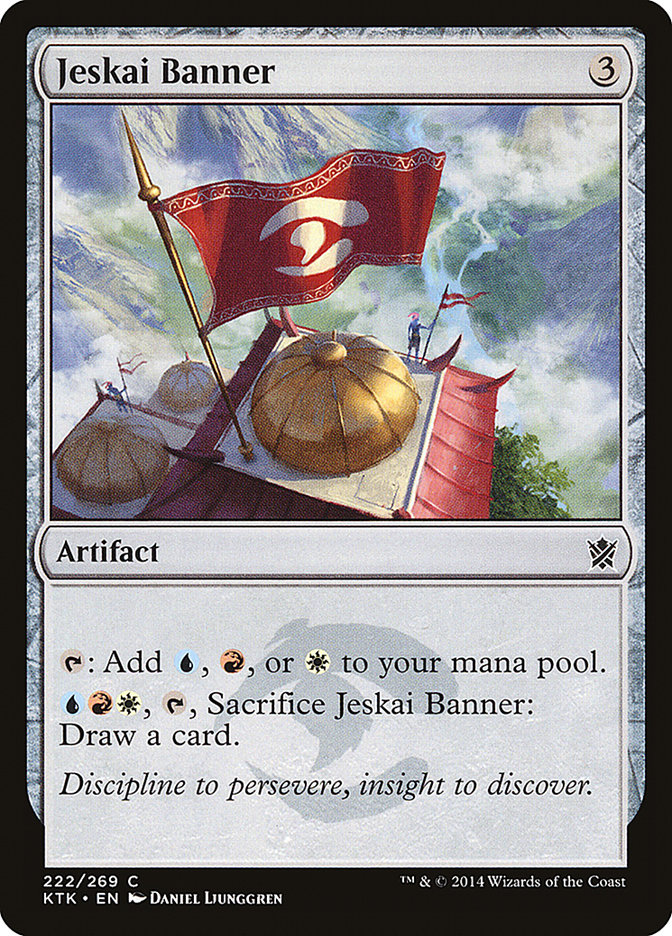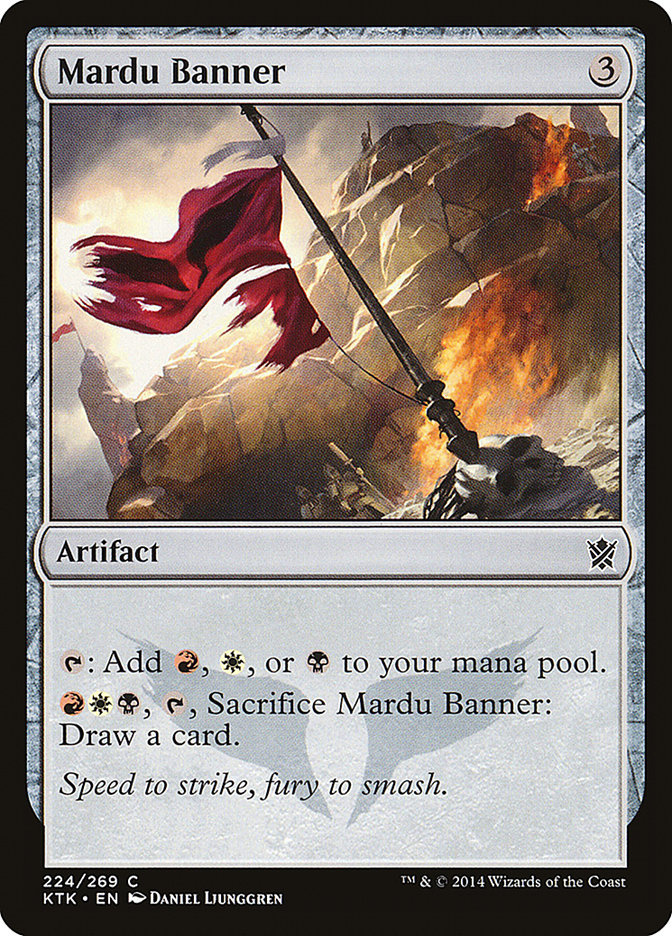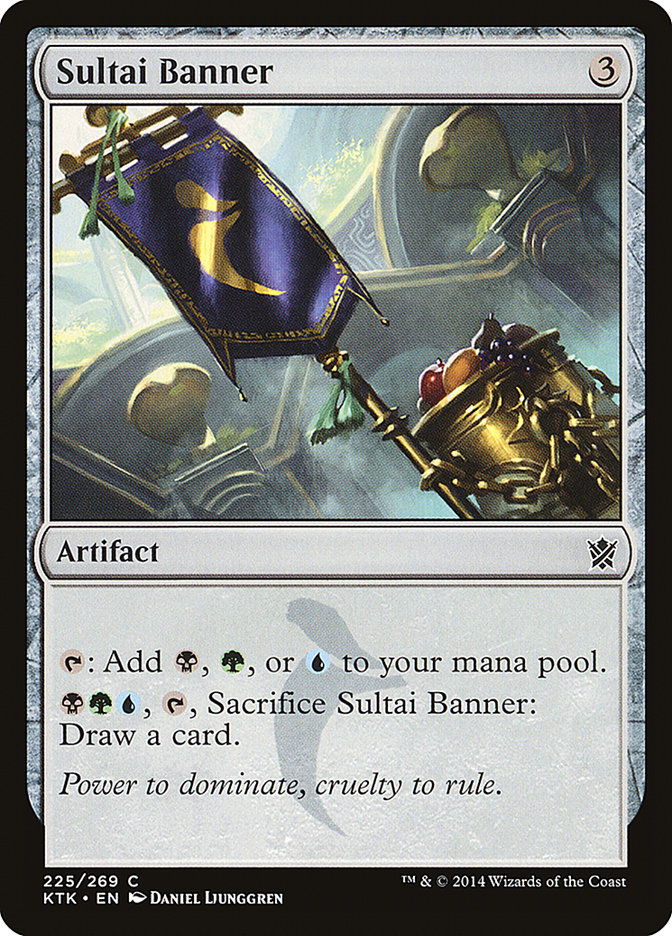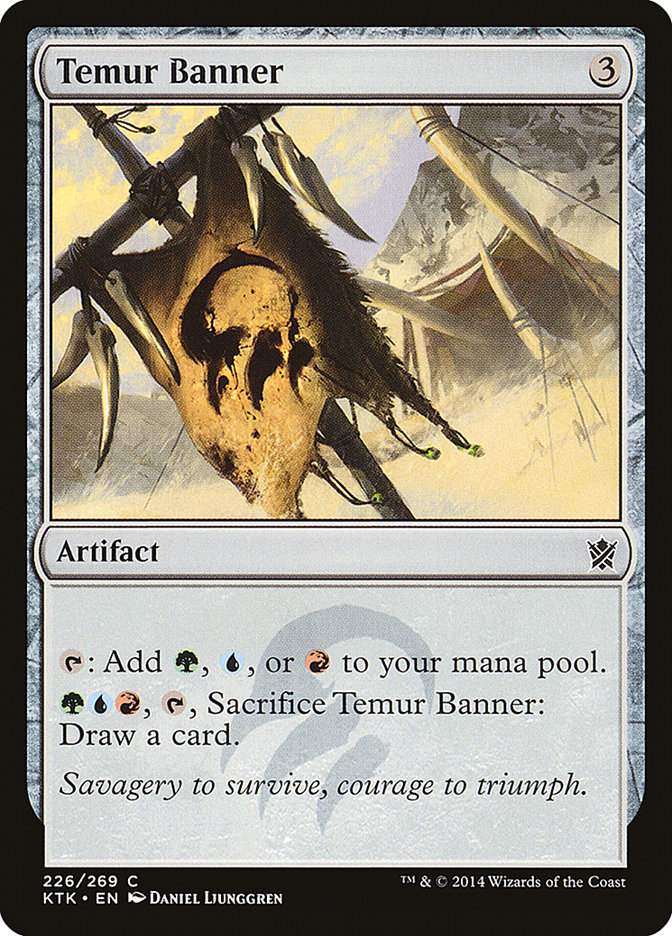This prerelease kind of snuck up on me. I actually had it in my head that the prerelease for Khans of Tarkir was going to be next weekend, on September 27,
It’s important to note that this prerelease is going to work differently than those of the past few years. Ever since Ravnica block, Wizards has given
and I was surprised when the full spoiler for the set was published last week. But it turned out that I was mistaken, and we’ll all be able to get our
hands on the new cards a week earlier than I expected. No complaints here!
players the option of choosing the guild, or color, or in the case of the new set, the clan they want to play. This choice came with it a seeded pack that,
until now, always included a specific rare prerelease card.
A lot of players weren’t big fans of this approach, because it led to many people feeling like they had to choose whichever option would give them the most
powerful prerelease card. Many stores quickly ran out of whatever color was perceived to be the best, leading to unhappy people who couldn’t get the color
they wanted. On top of that, many players felt that the same rares always showing up made the experience less fun overall, simply because games played out
very similarly.
To address these concerns, WotC made changes to the seeded prerelease packs. Instead of being guaranteed a specific card, choosing a clan means that you’ll
get one of eight possible rares. The pack will also contain all cards in the colors of that clan, so you’re far less likely to run into the problem of
picking your favorite color and then not getting enough good cards to actually play it. If the Ravnica guild packs were any indication, I imagine we’ll
also see tri-lands and banners in the seeded packs.
This should mean picking a clan is pretty much guaranteed to give you the tools to play that clan without making every clan deck look totally alike, which
sounds like a big improvement over the previous system. Additionally, no one will feel pressured to pick a color they don’t particularly enjoy because it
has a better prerelease card than another, or feel foolish for picking their favorite because its card is bad. I had picked green (or a green guild) ever
since the seeded packs were introduced, and yet for M15 I decided to go with red simply because Phytotitan seemed so much worse than Siege Dragon.
I mean, for starters, it’s not even a dragon…
This time though, I’m following my heart and going with Temur. I have Abzan inclinations as well, but Temur’s mechanic is just too archetypically me. I
remember when people asked me if my PT Chicago 2000 deck’s theme was “Creatures with Five or More Power” because it was full of Blastoderms and Jade
Leeches and Ancient Hydras – and, of course, Rith. Temur’s clan mechanic is exactly that deck’s theme – how can I go wrong?
But for those of you who are a little less set in your ways than I am, today I want to take a look at each of the clans for the prerelease this weekend and
examine what they offer in their mechanics. I also want to take a look at some of the key commons that you’ll want to look out for and keep in mind while
you play.
Before we actually go into the clans or cards themselves, let’s talk about one of the big mechanics in the set – Morph. Back in Onslaught block, I loved
playing with morph, because it rewarded format knowledge and the ability to read game states and play sequences. Being able to predict which morphs your
opponent might have and figuring out how best to play around them was pretty much the most important skill in the format. Nuances like whether you wanted
to wait until you put damage on the stack before flipping your morph or not were huge contributors to success, as was the ability to predict “Skirk
Commando or Battering Craghorn?”
Morphs in Khans of Tarkir are a much different breed. Rather than Commandos and Craghorns, or even Daru Lancers and Gravel Slingers with
damage-on-the-stack tricks, the morphs in Khans are much friendlier to play against. There aren’t creatures that will blow you out based on whether you
block or not with a similar morph-sized creature in the early turns of the game. In fact, there isn’t a single creature with an unmorph cost less than five
that can actually kill a 2/2 creature in combat without dying itself! Once you get to five mana, you start finding things that can morph into 4/4s and 5/5s
and the like, but in the early game, you can attack and block knowing that you’re not just going to get completely blown out by your opponent’s morph.
Let’s take a look at the clans themselves.
Abzan
When it comes to alphabetical order, it’s hard to beat a name that starts with “Ab.” Abzan is the clan I would lean toward if it weren’t for my devotion to
Temur. This is both because it’s a green clan – I have played my share of Doran-style decks in my day – and also because its apparent style of play is one
I really enjoy in Limited. While I have a predisposition toward aggressive decks in Constructed, I lean much more toward more controlling decks in Draft,
and particularly in Sealed Deck.
The less consistent decks are, as they tend to be in Limited formats when compared to Constructed, the more likely individually powerful cards or cards
that produce significant resource advantages are to win games. This makes the Abzan mechanic, outlast, a very attractive one. In any game that draws out
over an extended period – which seems to be very much Abzan’s thing – outlast does exactly what its name implies. It allows you to slowly eke out
advantages over your opponent and build closer to victory the longer the game goes on.
The Abzan commons that stand out the most to me are the ones that use outlast to its fullest. Mer-Ek Nightblade, for instance, gives all of your creatures
with +1/+1 counters Deathtouch, which is clearly a very powerful ability and combines especially well with the first strike granted by Ainok Bond-Kin.
While you can only activate outlast at sorcery speed, the ability-granting creatures combo especially well with tricks like Feat of Resistance or
Dragonscale Boon.
Abzan seems like a clan to make good use of Kill Shot, since their play pattern seems to be building up their forces to eventually overwhelm the opponent,
which means they’re definitely in the market for removal spells to take care of evasive creatures. For the same reason, they’re probably happy to pick up
Rite of the Serpent, even if it is particularly good against their own creatures, and Trottle seems like it may be more attractive here than its
predecessor Lash of the Whip.
Generally speaking, with Abzan you want to build your deck just to survive as long as possible, and allow the progressive value of your outlast cards to
carry you to victory. Cards like Salt Road Patrol seem like they’ll probably be much better than they look at first glance, because they contribute to both
keeping you alive by having good defensive stats and offer that late game value from their own outlast ability.
Jeskai
My most important question about Jeskai is if they were intentionally designed as the WUR-Tang Clan. If so, massive props to whoever came up with that
idea, because it’s fantastic. If not, it’s about the best color acronym accident ever.
Past that, Jeskai doesn’t really interest me nearly as much. Their core mechanic, prowess, is kind of like heroic in the sense that it pulls your deck in a
direction in which it wants to have a lot of spells that trigger it in order to get the best value out of your cards. Many Heroic decks suffered from the
problem of having too many payoffs and not enough ways to turn them on, or vice versa, and that was a format with bestow creatures that could serve as both
threats and enablers.
The bright side is that the prowess creatures are much stronger inherently than their heroic counterparts. The four common prowess creatures all have
reasonable stats. Bloodfire Expert is a 3/1 for 2R, Jeskai Student is a 1/3 for 1W, Jeskai Winscout is a 2/1 Flier for 2U, and Whirlwind Adept is a 4/2
Hexproof for 4U. None of these cards really stand out, but none of them are cards I’d be embarrassed to have in my deck without a lot of ways to activate
prowess. Okay, except maybe Whirlwind Adept. A two toughness five drop in a world of morphs does seem pretty embarrassing.
The cards that I would mostly be looking for if I were playing Jeskai – other than just quality creatures, of course, which make up the core of any solid
Limited deck – are instant-speed removal and tricks. Instant speed is particularly important because it allows you to activate prowess mid combat to
potentially mess with the math. The cards that stand out to me are things like Bring Low, Defiant Strike, the previously mentioned Feat of Resistance, and
even Weave Fate or Temur’s Force Away. Smite the Monstrous is relatively situational, but I’d probably maindeck one copy. It’s clearly great against Temur,
and will eventually work on Abzan creatures too. Kill Shot seems less exciting to me in Jeskai than Abzan because it seems like Jeskai wants to be more
aggressive, but if you have an evasion heavy deck that’s looking to fend off big creatures on the ground, I could see being in the market for the effect.
Overall, Jeskai doesn’t seem great to me. Its core mechanic looks more fancy than functional. I’m sure good Jeskai decks are possible, but they seem like
they’ll require more to go right than with some of the other clans.
Mardu
Mardu, on the other hand, seems pretty powerful. Their core mechanic is raid, which causes cards to provide bonus effects on turns in which you have
attacked with a creature. I generally just call those “turns”, so it seems right up my alley.
Raid means that Mardu is looking to turn creatures sideways whenever possible, which means that cards that facilitate that plan are especially potent here.
That said, it’s important to keep in mind that cards with raid triggers when they’re played, so you need to have the mana to actually play them after
you’ve attacked. This makes cards like Act of Treason – which is great for setting up a good turn to attack – less attractive as an enabler than they
otherwise would be, because you can’t easily use them to enable your raid cards in the early game.
What you are looking for more than anything else are cheap creatures that can attack. I wouldn’t be surprised if many of the best Mardu decks are built
primarily by playing as many solid two drops as possible. Ainok Bond-Kin and Jeskai Student are great ways to be able to get aggressive early that have
ways to discourage opponents from blocking, and Leaping Master is a good early drop that has a built in way to keep getting through later in the game.
While there are some solid payoffs at common for raid, like Mardu Hordechief and Mardu Skullhunter, the really exciting stuff is in the uncommons.
Bellowing Saddlebrute is a huge body for four mana that comes with a steep additional cost if you aren’t attacking, and Mardu Heart-Piercer is like a mini
Flametongue Kavu. It’s possible that the real sleeper of the bunch is Mardu Warshrieker though, especially if you’re able to pick up multiple copies to
chain together an army of them off one another’s triggers early in the game.
Sultai
Sultai is another clan that seems like it goes through a lot of fanciness for a questionable payoff. Their core mechanic is delve, and they generally use
their graveyard as a resource in various ways. This set has a lot of ways to fill your graveyard, though most of them are relatively inefficient. You can
only spend so much time and mana messing around with stuff like Bitter Revelation, Scout the Borders, Taigam’s Scheming, or Raksasha’s Secret.
The payoffs at common don’t even seem that exciting either. Hooting Mandrils, Shambling Attendants, Sultai Scavenger, and Treasure Cruise are all
overcosted by quite a few mana. If you aren’t filling your graveyard quickly, they’ll just sit and rot in your hand all game. Once you get to the uncommons
though, there are both better payoffs and better enablers. Murderous Cut is at the top of the first list, offering unconditional instant removal that is
only a couple mana north of what you might expect without delve. The best of the enablers looks to be Sultai Soothsayer, which not only fills your
graveyard, but also gives you card selection and a totally reasonable body for five mana.
Just by looking at the spoiler, Sultai seems like it’s fighting an uphill battle, since its cards don’t seem all that remarkable and they seem highly
dependent on the right synergies manifesting. With the right mix of each, I’m sure it can be a powerful deck, but even then there are any number of
anti-graveyard cards in the set, many of which are pretty big hosers like Burn Away or Cranial Archive, to say nothing of Anafenza. I’m not sure that’s the
kind of position I’d want to put myself in.
Temur
Now we get to the true rulers of Tarkir. Unlike prowess or delve, there’s nothing fancy about ferocious, but there doesn’t need to be. You don’t need to go
out of your way to play anything but big creatures to get the most out of your cards – and isn’t that something we all want to do anyway?
There aren’t a ton of ferocious cards in the set, and their payoffs aren’t huge, but they don’t ask very much to get value from them. Many of them, like
Force Away or Savage Punch, are totally reasonable on their own, but still power up pretty significantly once you can trigger ferocious. In Draft, that
does mean that other people are more likely to scoop them up even if they aren’t playing Temur themselves, but in sealed deck it just means your deck is
going to operate more consistently because it isn’t particularly reliant on synergies manifesting in order to win.
Beyond ferocious cards – and especially the extremely powerful uncommon and rare ones like Icy Blast, Roar of Challenge, Heir of the Wilds, and Crater’s
Claws – what Temur decks are mostly interested in are creatures, and big ones at that. Because Temur decks are likely to have higher curves than many other
clans in order to support big creatures, cards like Embodiment of Spring that provide mana acceleration seem like they could strong as well.
Don’t just try to jam a bunch of giant creatures in your Temur deck. Just because you have a few ferocious cards doesn’t mean every creature in your deck
has to have four power, and you should be sure to pay attention to your curve so you don’t just get run over by Mardu decks. I imagine that Temur players
will be especially interested in some of the larger morph creatures like Glacial Stalker, and of course, Snowhorn Rider, and also some of the green outlast
creatures like Longshot Squad that can come down early and then turn ferocious with a little bit of effort. Outside of creatures, Temur is probably the
faction best suited for Swift Kick, since it’s naturally going to have bigger creatures than Mardu or Jeskai decks. Because you don’t have to limit your
bear-violence to just punching.
No matter what clan you choose, one final piece of advice: don’t try to go too wild with your mana. It’s always tempting in any set with a lot of gold
cards and mana fixing to just try to play all of the best cards in your pool and hope you can actually cast them, but this format in particular seems to
have the tools for strong, consistent aggressive decks that can easily punish you if you try to get too greedy. When in doubt, stick to no more than three
colors, and even then only a combination in which you have the appropriate mana fixing. Jamming every rare in your pool across five colors in into your
deck may seem like a good idea when you’re building it, but it will seem like a lot worse of a plan when you sit down against someone playing Mardu who
just runs right over you.
What do you think? What are the key cards to look out for in the prerelease this weekend? Which clans do you think will come out on top?

